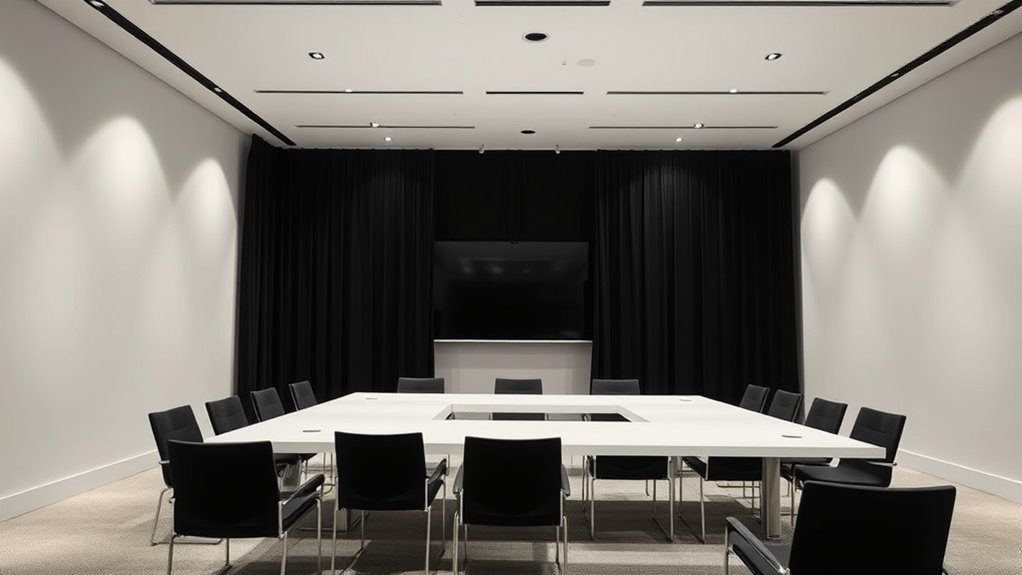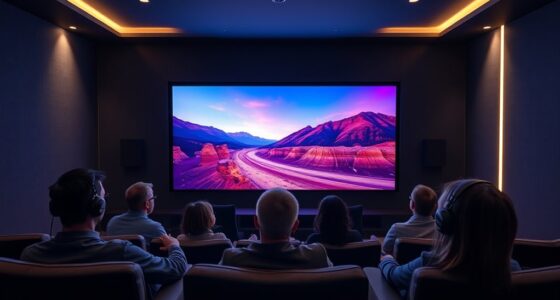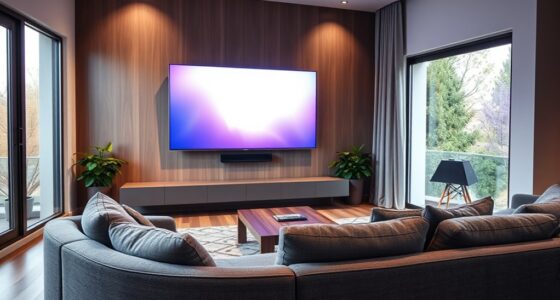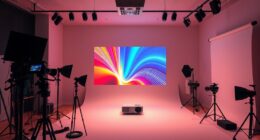Using black panels or curtains for screen masking helps you focus attention, hide distractions, and create a cleaner look. You can conceal equipment, backstage areas, or unwanted parts of your display to improve visual clarity. This technique is essential in projection mapping, theater, and presentations to control what the audience sees. If you keep exploring, you’ll discover even more innovative ways to enhance your visual setups effectively.
Key Takeaways
- Masks displays to direct viewer attention and improve visual clarity in projection mapping and theatrical setups.
- Conceals equipment or backstage areas to maintain immersion and prevent distractions during performances.
- Controls light spill and enhances contrast for clearer, more professional visual presentations.
- Hides sensitive information or confidential content on screens, supporting privacy and security needs.
- Facilitates seamless integration of projections with complex surfaces and physical environments.
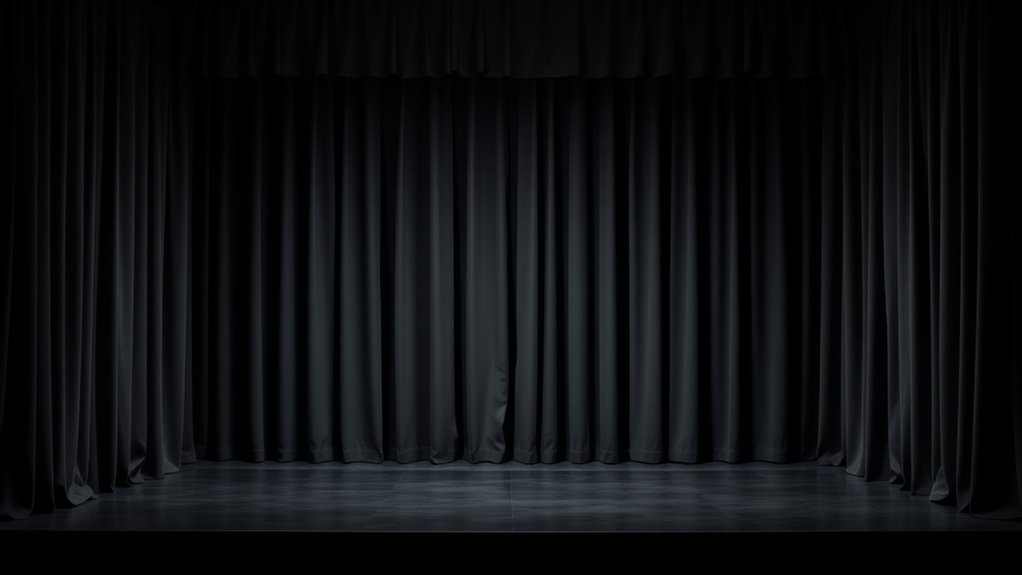
Screen masking is a powerful technique used to regulate what parts of your digital displays are visible, helping you focus, protect privacy, or enhance visual clarity. When you use black panels or curtains for masking, you can shape the viewer’s experience by hiding unwanted areas or emphasizing specific content. This approach is especially useful in complex setups like projection mapping events or theatrical productions, where precise control over what is seen matters. With projection mapping, for example, masking allows you to project images onto irregular surfaces while concealing surrounding areas that shouldn’t be illuminated. By strategically placing black panels or curtains, you can create a seamless visual experience, making the projected imagery appear to interact with real-world objects or backgrounds. This not only enhances the aesthetic appeal but also ensures that the audience’s attention stays focused on the intended visuals. Incorporating visual harmony into your masking strategy can further improve the overall effect. Backstage concealment is another critical aspect of screen masking. In performances or live events, you often need to hide equipment, crew, or other behind-the-scenes elements from the audience’s view. Black curtains or panels serve as effective barriers, camouflaging the behind-the-scenes activity without drawing attention. This concealment preserves the illusion, whether it’s a theatrical scene or a live presentation, maintaining the immersion for your viewers. Additionally, blackout curtains or panels can be used to limit light spill, improving the contrast and clarity of projected images or displays. This control over the environment helps you create professional, distraction-free settings that highlight your core visuals. Beyond performances, screen masking with black panels or curtains also plays a role in privacy and security. By blocking off certain areas of a screen or display, you can prevent sensitive information from being visible to unauthorized viewers. This is especially relevant in corporate settings or during presentations where confidential data is involved. Masking allows you to hide portions of a screen, ensuring that only the relevant information is displayed at any given time. The flexibility of using black panels or curtains means you can easily adjust or remove them as needed, giving you dynamic control over your visual environment. In all these applications, the simplicity and effectiveness of black panels or curtains make them indispensable tools. They help you craft a controlled visual space where focus, privacy, and aesthetic are seamlessly managed. Whether you’re enhancing projection mapping, concealing backstage areas, or protecting sensitive information, screen masking with black materials gives you the precision and adaptability to meet your specific needs.
Frequently Asked Questions
What Are the Best Materials for Blackout Curtains?
The best materials for blackout curtains are tightly woven fabrics like polyester or cotton blends, which effectively block light. Look for fabrics with a dense, smooth surface to enhance blackout capabilities. These materials also offer good insulation properties, helping to keep your room warmer in winter and cooler in summer. Consider adding a blackout lining or thermal backing for even better light blockage and insulation, ensuring a comfortable, dark environment.
How Do I Install Masking Panels Securely?
Installing masking panels is like anchoring a ship securely. To guarantee they stay in place, follow these tips: use sturdy mounting options such as wall brackets, hooks, or track systems. Make sure to measure precisely and drill into wall studs for added support. Use appropriate anchors and screws based on your wall type. Confirm the panels are level and firmly attached, so they won’t shift during use.
Can Masking Screens Be Reused or Repositioned Easily?
Yes, masking screens are generally reusable and designed for repositioning flexibility. You can easily move or reattach them as needed, making them a practical choice for dynamic setups. Reusability concerns are minimal if you handle them carefully and store them properly. Their lightweight construction and simple mounting options allow you to quickly adapt your space without hassle, ensuring efficient use across different scenes or presentations.
What Maintenance Is Required for Blackout Panels?
You need to regularly maintain blackout panels by cleaning the panels to keep them dust-free and looking fresh. Use a soft, damp cloth for panel cleaning, avoiding harsh chemicals that could damage the curtain material. Check for signs of wear and tear to guarantee curtain durability, and repair or replace any damaged sections promptly. Proper upkeep ensures your blackout panels remain effective and last longer in your setup.
Are There Eco-Friendly Options for Screen Masking Materials?
Think of eco-friendly fabrics as the green leaves in your theater’s forest—they let you mask screens without harming the environment. You can opt for sustainable materials like organic cotton, hemp, or recycled polyester, which reduce your carbon footprint. These options are durable, easy to clean, and environmentally responsible, helping you create a sustainable setup while maintaining ideal screen masking. Choosing eco-friendly fabrics ensures your space stays green and responsible.
Conclusion
Think of screen masking as a masterful artist’s brush, gently hiding unwanted details to reveal only what’s essential. Just as a curtain transforms a stage into a world of endless possibilities, black panels or curtains shape your scene’s story, guiding your audience’s focus. When you skillfully mask, you’re crafting a seamless illusion—an elegant dance of visibility and concealment—turning your set into a stage where imagination takes center, and everything else quietly fades into the background.
